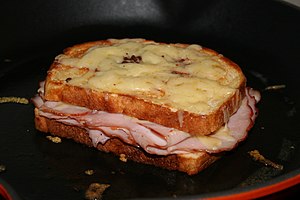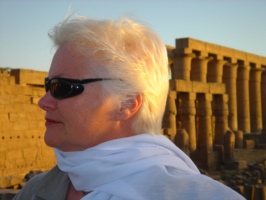Wednesday, October 24, 2007
I had been searching for a certain tiny shop at 6, rue d’Echaude in the Latin Quarter for weeks. The shop features items from the not-just-for-children’s book Le Petit Prince. Sadly, the shop has changed idols. Number 6 is now “Pixi & Cie,” featuring books, cards, and dolls of the Belgian comic character Tin Tin. On my recent visit, I bought some Tin Tin items plus a little two-inch-tall Petit Prince doll (below) from a forlorn bin. With no Parisian shop left to honor him, what is essential is now invisible to the eye.
    
The Little Prince is the title character from author-aviator Antoine de Saint Exupery’s 1943 book, Le Petit Prince (The Little Prince). Though Saint Exupery wrote other books, Le Petit Prince brought him worldwide fame. My mother used to recite from the book which she had learned in her schoolgirl days in Cleveland.
(Continued)
Tuesday, October 23, 2007
I’m not always out and about in Paris. I’m often back at my apartment by late afternoon. I read, write, clean up the place, do a load of wash, and watch TV. My apartment is hooked up to cable, so I get lots of channels. But only five of them are in English. I can enjoy watching “Law and Order” in French . . . for a few minutes anyway. With French voiceovers, I have also watched “That ’70s Show,” “Starsky and Hutch,” “The Simpsons,” “Hogan’s Heroes,” “Without a Trace,” “Bewitched,” “American Chopper,” “Dirty Jobs,” “Parental Control,” “South Park,” “Happy Days,” Bob L’Esponge (Sponge Bob), “Tom and Jerry,” “The O.C.,” “Dharma and Greg,” “Friends,” “Smallville,” and “Pimp My Ride.” I’ve seen the original American “Pimp” shows here with Xzibit and the International versions with Fat Joe.

The channels I get in English are France Anglais, CNN, BBC World News, BBC Prime (so I can get a fix of the brilliant British soap EastEnders), CNBC (to track how badly the dollar is doing), and Al Jazeera English. But those channels aren’t exactly veg-out viewing. They broadcast serious economic, political, environmental, and cultural stuff, plus specials on disturbing topics from child slavery in Benin to warriors for God to the missing monks in Myanmar. Al Jazeera English does particularly masterful programs about women around the world.
(Continued)
     Â
        Â
   Â
My friend and I went on a Cityrama Tour, one of those tours where a group of tourists get driven in Louis XIV opulence aboard a giant, shiny, egg-yolk- colored bus. Champagne country wasn’t a destination I’d have chosen on my own, but my friend wanted to go, so, despite my lived-in clothes and running shoes and natural tendencies, I was dragged into respectability, culture, and the higher classes.
(Continued)
Saturday, October 20, 2007
Here’s the second set of films set in Paris, with films listed by title M-Z. (See former post for the film title list from AÂ through L.)
Marie Antoinette. Choose the 1938 version with Norma Schearer and Tyrone Power, or the 2006 film with Kirsten Durst and Jason Schwartzman.
 Â Â Â Â
    
Le Million. 1931. One of the first musical comedies to be shot in sound.
(Continued)
There are many movies set–or partially set–in Paris. From my own memory and various Web sites, I’ve compiled the following list. I have seen only a handful of these myself and relied on Rotten Tomatoes for dates and other comments. You’ll notice that some French-to-English title translations aren’t literal. Double-check content, reviews, and language (in French only, subtitled, or dubbed?), before adding these to your Netflix queue.Â
Alice et Martin (Alice and Martin). 1998. Juliette Binoche in this mystery- character study.
Amelie (also known as Amélie from Montmartre and Le Fabuleux Destin d’Amelie Poulain). 2001. Audrey Tatou in a whimsical romance.

An American in Paris. 1951. Gene Kelly, Leslie Caron, and lots of dancing.
(Continued)
Thursday, October 18, 2007
When I walk southeast from my apartment along Rue Rambuteau, I quickly approach the huge exoskeleton of the Georges Pompidou modern art museum, first opened in 1977. The long escalator snakes up the museum’s west side (see the three views below). But the Pompidou itself isn’t my destination this morning. It’s the area around the Pompidou.
 Â Â Â Â
        Â
     Â
Â
This week it’s been colder in the mornings, so I’ve been going inside the cafes instead of sitting out on the sidewalk. The waiter turns on the hanging propane heaters, but even with the awnings reflecting the warmth, I prefer a table inside.
(Continued)
Wednesday, October 17, 2007
My cousin was born to visit Giverny: she told me she must visit Giverny if she did nothing else on her visit to Paris. Seeing Claude Monet’s gardens and studios was what she had to do before she died. There was no getting around it, so we bought tickets for the Cityrama bus tour to this small town in Normandy.
 Â Â Â Â
        Â
    
Patricia our guide was perfect: 2″ heels with a brisk walking style, short gray upswept hair, perfectly enunciated English, a paisley scarf that never shifted on her shoulders, a no-nonsence manner, and a lime green umbrella with a duck’s head on the handle that she held up so stragglers could find our tour group. Patricia’s first lesson: Claude’s last name is pronounced “MOE-nay,” not “moe-NAY.”
(Continued)
Tuesday, October 16, 2007
A croque-monsieur (translated as Mr. Crunchy, maybe?) is a toasted or broiled cheese sandwich, sold in restaurants and at many street stands throughout Paris. The cheese in a croque monsieur is typically gruyere or Swiss. The bread, unfortunately, is a standard white bread, and the meat is usually jambon (ham), but I’ve also seen chicken used. A fancier–and fattier and messier–croque might have a cheese sauce on top.
The word croque comes from the verb croquer, “to crunch,” and you certainly do that as you consume a crispy, hot, flavorful croque in a paper wrapper as you walk down the street or with a knife and fork on the plate in front of you at a cafe.

(Continued)
There are 36 bridges that cross the Seine river in Paris. If I walk straight south from my apartment, I cross the river at Pont Neuf, the “New Bridge.” This is a bit confusing, since “neuf” also means “nine” in French. There is a bar near me on Rue de Pont Neuf called “Pont 9.” Even more confusing is the fact that Pont Neuf is Paris’ oldest standing bridge, built 1578-1607. But this bridges’ 12 arches were new at the time since their design did not include the usual homes and other buildings sprouting on top.
Post Neuf is my closest way to cross the river, so it’s my home bridge. Actually Pont Neuf crosses the Seine twice as the bridge slices through the western prow tip of the river island Ile de la Cite.
(Continued)

Public drinking fountains in the form of small cast-iron sculptures are scattered throughout Paris. They are “Wallace fountains,” named after Richard Wallace, an Englishman who was raised in Paris by his grandmother. Wallace designed and financed the fountains’ construction, installing them after the Franco-Prussion War (1870-71).
      
The siege of Paris and the Commune destroyed many aqueducts in the 1870s. The poor were unable to get water without having to pay a lot for it. Richard Wallace inherited a large fortune from his father in 1870, so he decided to help all Parisians.Â
(Continued)















